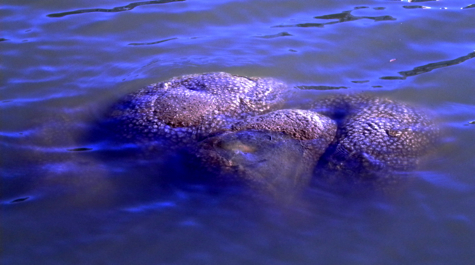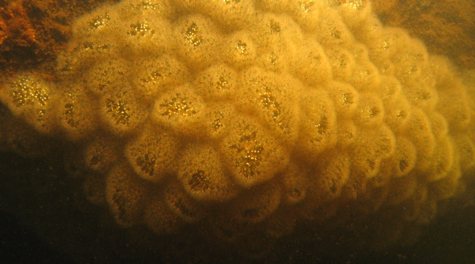VIMS scientists help solve mystery of “alien pod”
UFO—unidentified floating object—haunts lake at City Center
Tracy Collier, an employee at Home Technologies in City Center at Oyster Point, was walking her employer’s Westie around the Center’s manmade lake on Thursday when she saw a large, mysterious blob floating in the water.
Co-worker Charlie Schmuck says “The lake is behind our office. Tracy was walking by the lake, saw the object, and asked everyone else to come out and take a look.”
Tracy thought it was “a huge dead snake.”
Charlie thought it “looked like some weird underwater fungus, like the ones that explode when you poke them.”
Perhaps because it was just a few days before Halloween, co-worker Dale Leonart’s initial guess was that "it has to be an alien pod." After further consideration, he thought it might be some type of sponge.
Hoping to solve the mystery, Charlie took some pictures of the object and e-mailed them along with a description to the Virginia Institute of Marine Science in Gloucester Point.
The scientists at VIMS were equally intrigued. The e-mail read “The object is about 4 feet in diameter. It has moved about 6 feet down the shoreline in the last 24 hours. It 'jiggles' when the waves in the lake hit it… when we prod it, it seems to be spongy feeling… The texture appears to be that of a rock with algae spots on it—it is brown and yellow, with a pattern of some type.”
A brief flurry of internal e-mails followed. The marine tunicate Eudistoma hepaticum? Unlikely, as the lake contains fresh water. A Halloween prank in which someone moved a marine organism to the lake? Perhaps. The final consensus was that the organism is Pectinatella magnifica—the "magnificient bryozoan."
"Moss Animals"
That identification is itself somewhat surprising, as the vast majority of bryozoans—thousands of species—live in salt water. Marine bryozoans are common but inconspicuous filter feeders that grow in thin, encrusting colonies atop rocks, kelp blades, shellfish, and other hard objects. When the individual animals extend their tentatcles to feed, the colony takes on a fuzzy appearance, hence the bryozoans’ common name of “moss animal.”
Although individual bryozoans are built on a simple plan—a U-shaped gut inside a bag-like body with no lungs or gills, and no circulatory or excretory system—they are true survivors, with a fossil record that dates back some 500 million years.
Freshwater bryozoans are far less diverse than their marine cousins, with only about 50 species worldwide, but what they lack in numbers they make up for in size—like the 4-foot blob found floating in Newport News. The City Center blob is actually much larger than most reports for the species, which put a large colony at only 1-2 feet across.
Colonies of Pectinatella magnifica feature a surface layer of adjoining "rosettes"—each with 12-18 animals or "zooids"—around a central jelly-like mass that is 99% water. The colonies can be free floating or attached to a piling or other submerged object. One study even showed that young colonies of P. magnifica can actually move on their own by coordinated pulsing of the individual animals.
VIMS professor Carl Hershner notes that bryozoans consume algae, so the “alien pod” is “actually a good thing to have around, despite its looks.” ”It's not a sign of bad water quality,” he adds, “and it doesn't hurt fish. It can clog pipes, though, and it will be smelly if it’s removed from the water.”
Anyone who finds a “UFO” (unidentified fishy object) in Chesapeake Bay or surrounding waters and would like help in identification is encouraged to visit www.vims.edu/bayinfo/ufos or to submit a digital photo and description (location, size, shape, color, behavior, etc.) to vimspr@vims.edu.




